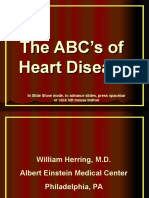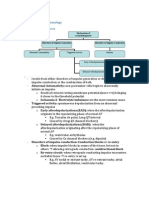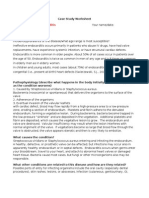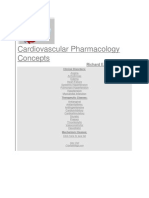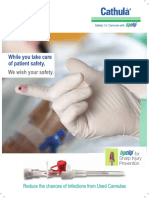Defibrillation
Defibrillation
Uploaded by
Jara Maris Moreno BudionganCopyright:
Available Formats
Defibrillation
Defibrillation
Uploaded by
Jara Maris Moreno BudionganOriginal Title
Copyright
Available Formats
Share this document
Did you find this document useful?
Is this content inappropriate?
Copyright:
Available Formats
Defibrillation
Defibrillation
Uploaded by
Jara Maris Moreno BudionganCopyright:
Available Formats
Defibrillation
Definition Defibrillation is a process in which an electrical device called a defibrillator sends an electric shock to the heart to stop an arrhythmia resulting in the return of a productive heart rhythm. Purpose Defibrillation is performed to correct life-threatening arrhythmias of the heart including ventricular fibrillation and cardiac arrest. In cardiac emergencies it should be performed immediately after identifying that the patient is experiencing an arrhythmia, indicated by lack of pulse and unresponsiveness. If an electrocardiogram is available, the arrhythmia can be displayed visually for additional confirmation. For medical treatment by a physician, in nonlife threatening situations, atrial defibrillation can be used to treat atrial fibrillation or flutter.
Precautions Defibrillation should not be performed on a patient who has a pulse or is alert, as this could cause a lethal heart rhythm disturbance or cardiac arrest. The paddles used in the procedure should not be placed on a woman's breasts or over an internal pacemaker. Cardiac arrhythmias that prevent the heart from pumping blood to the body can cause irreversible damage to the major organs including the brain and heart. These arrhythmias include ventricular tachycardia, fibrillation, and cardiac arrest. About 10% of the ability to restart the heart is lost with every minute that the heart fibrillates. Death can occur in minutes unless a productive heart rhythm, able to generate a pulse, is restored through defibrillation. Because immediate defibrillation is crucial to the patient's survival, the American Heart Association has called for the integration of defibrillation into an effective emergency cardiac care system. The system should include early access, early cardiopulmonary resuscitation , early defibrillation, and early advanced cardiac care.
Defibrillators deliver a brief electric shock to the heart, which enables the heart's natural pacemaker to regain control and establish a productive heart rhythm. The defibrillator is an electronic device that includes defibrillator paddles and electrocardiogram monitoring. During external defibrillation, the paddles are placed on the patient's chest with a conducting gel ensuring good contact with the skin. When the heart can be visualized directly, during thoracic surgery , sterile internal paddles are applied directly to the heart. Direct contact with the patient is discontinued by all caregivers. If additional defibrillation is required the paddles should be repositioned exactly to increase the likelihood of further shocks being effective in stopping the arrhythmia. The patient's pulse and/or electrocardiogram are continually monitored when defibrillation is not in progress. Medications to treat possible causes of the abnormal heart rhythm may be administered. Defibrillation continues until the patient's condition stabilizes or the procedure is ordered to be discontinued.
Early defibrillators, about the size and weight of a car battery, were used primarily in ambulances and hospitals. The American Heart Association now advocates public access defibrillation; this calls for placing automated external defibrillators (AEDS) in police vehicles, airplanes, and at public events, etc. The AEDS are smaller, lighter, less expensive, and easier to use than the early defibrillators. They are computerized to provide simple, verbal instructions to the operator and to make it impossible to deliver a shock to a patient whose heart is not fibrillating. The placement of AEDs is likely to expand to many public locations. Preparation Once a patient is found in cardiac distress, without a pulse and non-responsive, and help is summoned, cardiopulmonary resuscitation (CPR) is begun and continued until the caregivers arrive and are able to provide defibrillation. Electrocardiogram leads are attached to the patient chest. Gel or paste is applied to the defibrillator paddles, or two gel pads are placed on the patient's chest. The caregivers verify lack of a pulse while visualizing the electrocardiogram, assure contact with the patient is discontinued, and deliver the electrical charge.
Atrial defibrillation is a treatment option that will be ordered for treatment of atrial fibrillation or flutter. The electrocardiogram will be monitored throughout the procedure. The paddles are placed on the patients chest with conducting gel to ensure good contact between the paddles and skin. If the heart can be visualized directly during thoracic surgery, the paddles will be applied directly to the heart. The defibrillator is programmed to recognize distinct components of the electrocardiogram and will only fire the electrical shock at the correct time. Again, all direct contact with the patient is discontinued prior to defibrillation. Aftercare After defibrillation, the patient's cardiac status, breathing, and vital signs are monitored with a cardiac monitor . Additional tests to measure cardiac damage will be performed, which can include a 12 lead electrocardiogram, a chest x-ray, and cardiac catheterization . Treatment options will be determined from the outcome of these procedures. The patient's skin is cleansed to remove gel and, if necessary, electrical burns are treated.
Risks Skin burns from the defibrillator paddles are the most common complication of defibrillation. Other risks include injury to the heart muscle, abnormal heart rhythms, and blood clots. Normal results Defibrillation performed to treat life-threatening ventricular arrhythmias is most likely to be effective within the first five minutes, preventing brain injury and death by returning the heart to a productive rhythm able to produce a pulse. Patients will be transferred to a hospital critical care unit for additional monitoring, diagnosis, and treatment of the arrhythmia. Intubation may be required for respiratory distress. Medications to improve cardiac function and prevent additional arrhythmias, are frequently administered. Some cardiac function may be lost due to the actual defibrillation, but is also associated with the underlying disease. Atrial defibrillation is successful at restoring cardiac output, alleviating shortness of breath, and decreasing the occurrence of clot formation in the atria.
You might also like
- Janice Krug PMHNP ResumeDocument3 pagesJanice Krug PMHNP Resumeapi-416722296No ratings yet
- Jainism - CelibacyDocument5 pagesJainism - CelibacyDisha TNo ratings yet
- Handout Negligence and MalpracticeDocument2 pagesHandout Negligence and MalpracticeJudeLaxNo ratings yet
- Guidelines For The Management of Cardiovascular Diseases in IndiaDocument40 pagesGuidelines For The Management of Cardiovascular Diseases in IndiaViky SinghNo ratings yet
- Heart Disease JaninDocument7 pagesHeart Disease JaninTiara Anggun NurartoNo ratings yet
- The ABC's of Heart DiseaseDocument78 pagesThe ABC's of Heart DiseaseChRist LumingkewasNo ratings yet
- Causes, Symptoms, Pathophysiology and Diagnosis of Atherosclerosis-A ReviewDocument23 pagesCauses, Symptoms, Pathophysiology and Diagnosis of Atherosclerosis-A ReviewBaharudin WahyuNo ratings yet
- Types of Cardiovascular Disease in The HeartDocument7 pagesTypes of Cardiovascular Disease in The Heartissey1652No ratings yet
- Adrenergic DrugsDocument33 pagesAdrenergic DrugsZsa Zsa FebryanaNo ratings yet
- Trends and Issues Affecting Nursing Practice-Newest S-16Document81 pagesTrends and Issues Affecting Nursing Practice-Newest S-16Lorraine CayamandaNo ratings yet
- Payroll Management in Simhapuri Hospitals: 1.2 Industry ProfileDocument30 pagesPayroll Management in Simhapuri Hospitals: 1.2 Industry ProfilebhuvanaNo ratings yet
- Multivariate Analysis Spss Operation and Application: Student Name: Deniz Yilmaz Student Number: M0987107Document27 pagesMultivariate Analysis Spss Operation and Application: Student Name: Deniz Yilmaz Student Number: M0987107Denis YilmazNo ratings yet
- Chest Tube, Urinary Catheter, Ryles Tube InsertionDocument60 pagesChest Tube, Urinary Catheter, Ryles Tube InsertionMohd Johari Mohd ShafuwanNo ratings yet
- Employer Health InsuranceDocument55 pagesEmployer Health InsuranceSunil RawatNo ratings yet
- Cardiac DefibrillatorsDocument8 pagesCardiac Defibrillatorsصفا طلال نايفNo ratings yet
- About ZoroastrianismDocument7 pagesAbout ZoroastrianismRayyan FantasiNo ratings yet
- New Microsoft Word DocumentDocument5 pagesNew Microsoft Word DocumentVeronica Delos SantosNo ratings yet
- Aortic RegurgitationDocument12 pagesAortic RegurgitationSanjeet SahNo ratings yet
- Drugs Acting On Cardio Vascular SystemDocument16 pagesDrugs Acting On Cardio Vascular SystemANUSHYA B PSGRKCWNo ratings yet
- Eisenmenger SyndromeDocument2 pagesEisenmenger Syndromecarlo_nonNo ratings yet
- Angiotensin I Angiotensin II, Angiotensin-Converting Enzyme (ACE) - Vasoconstrictor Angiotensin II Stimulates Aldosterone SecretionDocument11 pagesAngiotensin I Angiotensin II, Angiotensin-Converting Enzyme (ACE) - Vasoconstrictor Angiotensin II Stimulates Aldosterone SecretionAbdullah asadNo ratings yet
- Cardiac Glycosides 815Document19 pagesCardiac Glycosides 815SanskritiNo ratings yet
- Central Venous Pressure MonitoringDocument27 pagesCentral Venous Pressure MonitoringOxy GenNo ratings yet
- Medications Used in Code Blue EmergenciesDocument24 pagesMedications Used in Code Blue EmergenciesAhmed Ali Mohammed AlbashirNo ratings yet
- Description of DiseaseDocument10 pagesDescription of DiseaseRajaNo ratings yet
- Tress Test: The Gale Encyclopedia of MedicineDocument7 pagesTress Test: The Gale Encyclopedia of MedicineSalsabilla KimikoNo ratings yet
- Arrhythmias + Pharmacology: Mechanism of ArrhythmiaDocument10 pagesArrhythmias + Pharmacology: Mechanism of ArrhythmiaJuliana Ching Joo LimNo ratings yet
- Circulation Study GuideDocument3 pagesCirculation Study Guideraanja2No ratings yet
- Suctioning Artificial Airways - AdultsDocument27 pagesSuctioning Artificial Airways - AdultssdaNo ratings yet
- Digitalis Toxicity Treatment and ManagementDocument39 pagesDigitalis Toxicity Treatment and ManagementAnonymous 3OoumAUytNo ratings yet
- Atorvastatin 0Document7 pagesAtorvastatin 0AgronaSlaughterNo ratings yet
- Cataract NotesDocument4 pagesCataract NotesJeremy LauNo ratings yet
- Cardiac EmergenciesDocument21 pagesCardiac Emergenciesgus_lionsNo ratings yet
- Respiratory Function TestDocument7 pagesRespiratory Function TestMarivic DianoNo ratings yet
- Cardiovascular DiseaseDocument33 pagesCardiovascular Diseasejoyce lakshmanNo ratings yet
- Case Study Worksheet EndocarditisDocument6 pagesCase Study Worksheet EndocarditisSharlee StoneNo ratings yet
- Cardiovascular Pharmacology ConceptsDocument11 pagesCardiovascular Pharmacology ConceptsHuney Kumar100% (1)
- Tracheostomy Care: PhysiologyDocument2 pagesTracheostomy Care: PhysiologyrajirajeshNo ratings yet
- Cardiac Arrhythmias Case FileDocument5 pagesCardiac Arrhythmias Case Filehttps://medical-phd.blogspot.comNo ratings yet
- Aneurysm: TypesDocument12 pagesAneurysm: TypesSofia Isabelle GarciaNo ratings yet
- Approach To The Cardiovascular Examination567 160120085414 PDFDocument22 pagesApproach To The Cardiovascular Examination567 160120085414 PDFHNINNo ratings yet
- Aortic StenosisDocument3 pagesAortic StenosisKhalid Mahmud Arifin100% (1)
- Pro32 SupraventricularTachycardiaDocument1 pagePro32 SupraventricularTachycardiaRonald KendallNo ratings yet
- IntroductionDocument13 pagesIntroductionSiyara AntonyNo ratings yet
- CardiologyDocument37 pagesCardiologyandreaNo ratings yet
- By: Prabhat Khare: Asst. ProfessorDocument25 pagesBy: Prabhat Khare: Asst. ProfessorSUMIT KUMAR PANDITNo ratings yet
- Cardiac Pacemakers NewDocument108 pagesCardiac Pacemakers NewAlif Fanharnita BrilianaNo ratings yet
- SP42 Thoracentesis (Adult)Document7 pagesSP42 Thoracentesis (Adult)Adam HuzaibyNo ratings yet
- Arrhythmias Teacher GuideDocument12 pagesArrhythmias Teacher GuideMayer Rosenberg100% (3)
- Examination of Pulse in Clinical MedicineDocument27 pagesExamination of Pulse in Clinical MedicineDon Vigis Abraham100% (1)
- Prosthetics: Marina Matta 3/18/17 John Overton High School Mrs. Spear Word CountDocument10 pagesProsthetics: Marina Matta 3/18/17 John Overton High School Mrs. Spear Word CountAnonymous l41NOHIc4tNo ratings yet
- Valvular Heart Disease. KulDocument60 pagesValvular Heart Disease. KulIntan Kumalasari RambeNo ratings yet
- Citation For Inside The TextDocument5 pagesCitation For Inside The TextShahriar HaqueNo ratings yet
- Vaishhnavi Record 1Document111 pagesVaishhnavi Record 1Monica PurushothamanNo ratings yet
- IHDDocument34 pagesIHDElly Msi ProbolinggoNo ratings yet
- Drugs Given During Cardiac Arres For CPRDocument5 pagesDrugs Given During Cardiac Arres For CPREevyaj MimiNo ratings yet
- Nursing Care PlanDocument5 pagesNursing Care PlanNicolne LorraineNo ratings yet
- Flail Chest 2Document16 pagesFlail Chest 2talithanrNo ratings yet
- TOF Patient EducationDocument8 pagesTOF Patient EducationMia MiaNo ratings yet
- Aortic RegurgitationDocument19 pagesAortic RegurgitationsunilgenextNo ratings yet
- Clinical Pathway-Pacemaker InsertionDocument2 pagesClinical Pathway-Pacemaker InsertionJanua Navarette100% (1)
- Ebstein Anomaly, A Simple Guide To The Condition, Diagnosis, Treatment And Related ConditionsFrom EverandEbstein Anomaly, A Simple Guide To The Condition, Diagnosis, Treatment And Related ConditionsNo ratings yet
- Chandigarh Masterplan 2031Document56 pagesChandigarh Masterplan 2031Dinesh DhakaNo ratings yet
- Cathula - While You Take Care of Patient Safety, We Wish Your SafetyDocument3 pagesCathula - While You Take Care of Patient Safety, We Wish Your SafetyHMD HealthcareNo ratings yet
- Airflow September DentistryDocument1 pageAirflow September DentistryCarolyn WilkinsonNo ratings yet
- English: 1. RestaurantDocument4 pagesEnglish: 1. RestaurantbabikaujinkNo ratings yet
- SDA - PPT - M Taha AliDocument12 pagesSDA - PPT - M Taha AliMuhammad Taha AliNo ratings yet
- Case Study FormatDocument5 pagesCase Study FormatEden OlasabNo ratings yet
- Ors Fluid Warming Sell Sheet ProductDocument2 pagesOrs Fluid Warming Sell Sheet ProductBrianNo ratings yet
- Chelsea Suppinger CV 2022 FinalDocument4 pagesChelsea Suppinger CV 2022 Finalapi-589685298No ratings yet
- Spacemed ArticleDocument4 pagesSpacemed ArticleBingDelaCruzNo ratings yet
- Filipino Patient's Bill of RightsDocument3 pagesFilipino Patient's Bill of RightsHazelNo ratings yet
- DEMENTIA Citical ExamDocument4 pagesDEMENTIA Citical ExamDerick RanaNo ratings yet
- Osce Pro III Trial AnswerDocument69 pagesOsce Pro III Trial AnswerDr Onn Azli Puade100% (3)
- 22 Careers in PharmacyDocument4 pages22 Careers in PharmacyGavin DingNo ratings yet
- River Valley News Shopper, October 10, 2011Document36 pagesRiver Valley News Shopper, October 10, 2011Pioneer GroupNo ratings yet
- The Benefits of TelemedicineDocument2 pagesThe Benefits of TelemedicineNirat Patel100% (1)
- Summa Health Statement On Cliff DevenyDocument2 pagesSumma Health Statement On Cliff DevenyJustin MaddenNo ratings yet
- Chronic Illness Acute Illness: CharacteristicsDocument4 pagesChronic Illness Acute Illness: CharacteristicsFerdinand Sherwin MorataNo ratings yet
- Quality Manual: Sta. Rosa Hospital and Medical CenterDocument15 pagesQuality Manual: Sta. Rosa Hospital and Medical CenterRenz Marrion RolleNo ratings yet
- 9 Essential Nursing SkillsDocument2 pages9 Essential Nursing SkillsNeric Ico MagleoNo ratings yet
- Social Internship: Report - 2018 AL Mustafa Welfare Trust InternationalDocument8 pagesSocial Internship: Report - 2018 AL Mustafa Welfare Trust InternationalKhuzaima AftabNo ratings yet
- AutobiographyDocument16 pagesAutobiographynccarlson22No ratings yet
- Management Information SystemDocument7 pagesManagement Information SystemSteffin JosephNo ratings yet
- Coldplay Fanfiction RUSH OF BLOODDocument105 pagesColdplay Fanfiction RUSH OF BLOODanna_lundh7229No ratings yet
- 2002 Magnetom Flash 2Document76 pages2002 Magnetom Flash 2Herick Savione100% (1)
- VocabMagik - Fall in Love With Vocabulary!Document106 pagesVocabMagik - Fall in Love With Vocabulary!VocabMagiikNo ratings yet
- Misak - Tolle Causam & Therapeutic OrderDocument1 pageMisak - Tolle Causam & Therapeutic OrderDarrell MisakNo ratings yet
- Recommendation Letter Maria HurtadoDocument1 pageRecommendation Letter Maria Hurtadoapi-641781710No ratings yet
- Catch Me If You CanDocument164 pagesCatch Me If You Cangordonyu888No ratings yet





